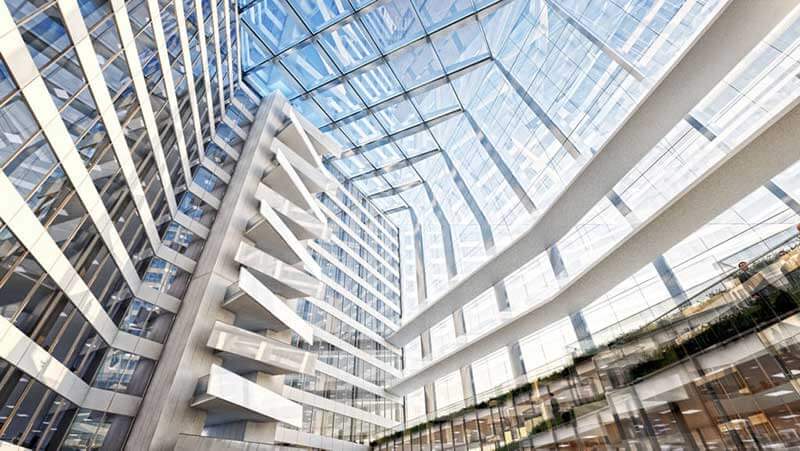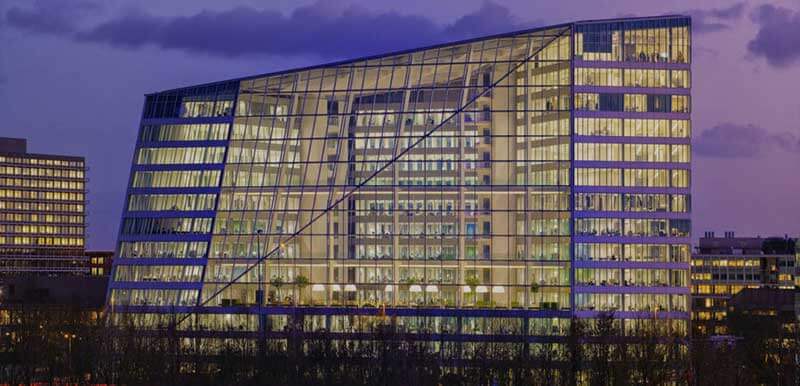- A catalyst for transitioning into the digital age
- The atrium – so much more than merely a grand statement
- The building knows who you are and what you’re about to do
- The Edge is the greenest and the smartest of them all
- Lighting and data via the Ethernet
- Smart buildings are what people want and our world needs
It’s not just technology that drives more intelligent buildings. There are increasingly overwhelming environmental factors, too, leading not only to more pressure to adopt green architecture, but also to more opportunities. Our responsibility to the environment, and the need to reduce cost and increase efficiency, have pushed architects and construction companies to work closer together to create increasingly intelligent buildings. One shining example is The Edge in Amsterdam, also called ‘The Computer with a Roof’. This incredible office building has received multiple awards and has been named the smartest and greenest building on Earth. For The Edge’s 2,600 employees, there’s no such thing as a typical day at the office. It’s an experience beyond what most people even dare to imagine. And it’s not hard to understand why. The place is so incredibly interesting, inviting, and fun, that people apply for jobs there just because they want to work in the building.
A catalyst for transitioning into the digital age
PLP Architecture were invited to design this 15-storey office building in 2009, which was developed by OVG Real Estate as the headquarters of the consulting firm Deloitte. It took a while to bring to fruition, but it was completed towards the end of 2014. The 40,000 m2 building in Amsterdam’s Zuidas, one of Europe’s most important financial and business districts, is comprised of an atrium, offices, conference facilities, a restaurant and café, an exhibition space, a gym, two storeys of underground parking, and 500 bicycle parking spaces. Other companies situated in the building are Salesforce, AKD, Edelman, Sandvik, and Henkel. The building boasts excellent connections to public transport, including a high-speed train station and cycle-route networks. On PLP’s website it says: “The ambition of the project was two-fold: to consolidate Deloitte’s employees, previously spread around multiple buildings throughout the city, within a single environment; and to create a ‘smart building’, intended as a catalyst for Deloitte’s transition into the digital age”. The Edge was awarded a 98.4 per cent sustainability score, the highest ever awarded by the British rating agency BREEAM, a global assessor of buildings’ sustainability.
The atrium – so much more than merely a grand statement
Boasting enormous windows and flooded with natural light, the 15-storey atrium is much more than merely a grand statement; it’s like a giant stage overlooked by the surrounding offices. It’s interspersed with balconies, walkways, and lifts that connect all the different spaces. Each workspace in the building is situated within 7 metres of a window, and the slanted roof provides a sound barrier from the highway and train tracks nearby. The atrium is the social nucleus and the ‘lungs’ of the building. It ventilates the office space while acting as a buffer between the interior and exterior, reducing energy usage throughout the seasons. The outdoorsy feel and loop of natural ventilation in the atrium are created by the air currents and slight heat variations in the building. The mesh panels between the floors enable stale air to move into the atrium, where it rises and escapes through the roof.

The building knows who you are and what you’re about to do
As an employee at The Edge, you don’t own a desk, which enables you to work where and how you want. This could be at a standing, sitting, or balcony desk, or even a more casual work booth. Then there are concentration or focus rooms and even exhibition spaces, as well as enormous flat screens around every corner that can be synced wirelessly with your laptop or phone. At The Edge, activity – whether it’s that of its users or the systems – is continuously monitored and analysed via its 28,000 sensors that track lighting levels, temperature, movement, humidity, and even carbon dioxide levels. This enables the building to react to its users’ needs and informs them, via a special app developed by Deloitte, which working spaces are available and which are most suitable for their tasks – such as meetings, phone calls, brainstorming, or presentations – throughout the day.
If that doesn’t sound incredible enough, the app actually connects with the employees from the moment they wake up and switch on their smartphones. It knows who you are, where you live, and what car or bicycle you use to get to work. As soon as you arrive, image recognition technology scans your licence plate, identifies you, and allocates a parking spot with a charging point for your electric car. Upon entering the building, you can use the app to locate your colleagues, find a work space that suits a specific requirement – depending on your schedule – and adjust the lighting, the blinds, the temperature, and even the height of your chair. Most employees enjoy the sense of control they have over their environment through the company app, and since the building opened, no employee has filed a comfort complaint. The personal data gathered by The Edge’s sensors is, by the way, not accessible to managers or bosses. Sensitive about privacy issues, Deloitte actually held surveys among their employees prior to implementing the number plate scanners. But most of the workers had no problem with the identification technology, as long as it made work more efficient.
Via wall-mounted screens and QR codes, employees can even select recipes and ingredients for their evening meals – so they don’t have to go to the supermarket after work. The groceries are then delivered via bicycle by the grocery store Bilder & De Clercq, before the end of the day. Unsurprisingly, the cutting-edge building makes its main tenant, Deloitte, an enormously attractive employer. We would be a little creeped out, however, by the robot security guard that looks a little like R2D2 autonomously patrolling the building at night.
The Edge is the greenest and smartest of them all
The Edge is covered with solar panels that produce more energy than they consume (some of their solar panels are also installed on the roofs of adjacent buildings). In fact, The Edge produces 102% of its energy needs. The building also stores rainwater – collected from the roof and balconies – in a large concrete tub at the back of the building. The rainwater is used to irrigate the gardens and indoor plants, and for flushing the toilets. A second storage reservoir, 130 m underground, works as an aquifer thermal energy storage system. It connects to the rest of the building, and circulates cold or hot water for cooling or heating.
The fitness equipment in the on-site gym harnesses the energy generated during exercise, which feeds into the power grid and is used to power various areas in the office building. The smart beverage machines at the coffee bars know exactly how you like your coffee or tea. The Edge even features an ecological corridor on the north-facing terrace of the building for use by local insect, bird, and bat populations. The path of vegetation supports beneficial insects by providing insect hotels, while birds and bats are offered birdhouses and bat boxes that provide shelter and space for nesting.

Lighting and data via the Ethernet
At The Edge, natural, as well as artificial lighting is manipulated in such a way that the building gets an incredibly high environmental IQ. The solid, double-glazed wall on the north side enables daylight to filter into all corners of the building with very little change to the inside temperature, while the south facade is completely covered with invisible solar panels. The Edge is the first office building in the world to have been fitted with the connected ‘Power-over-Ethernet’ lighting system, which enables 80 per cent energy savings in lighting alone, according to research by Philips. The sensors in the LED lighting system capture anonymous data on room occupancy and connect with the building management system (BMS) through the IT network, as well as with the ventilation and heating systems. The collected data allows for more optimal operational efficiency. This single system enables the facility manager to access not only historical, but also real-time information on how the building is used. If a particular room or floor isn’t in use at a particular time or day, the lighting and temperature can be adjusted accordingly. The lighting fixtures get their power, as well as their data, via a single, low-voltage Ethernet connection, eliminating the need for costly wiring.
Smart buildings are what people want and our world needs
In the increasingly connected era that we live in, old-fashioned, unconnected buildings are no longer viable. A smart building doesn’t mean, however, that we need to demolish each and every old building and build from scratch. Retrofitting existing buildings with smart technology is an increasingly popular option to provide greater sustainability and efficiency. The designers of The Edge are planning to change the future of architecture on a global scale. Someday, they envisage connecting all office buildings to each other, leading to a more efficient use of existing structures. Smart buildings that solve their own problems, generate their own energy, enhance the lives of their occupants, and reduce our collective carbon footprint are what people want and our world needs.
Share via:


